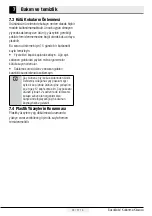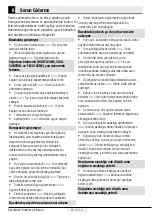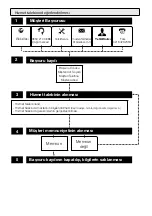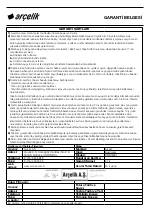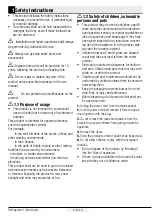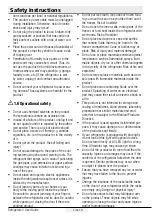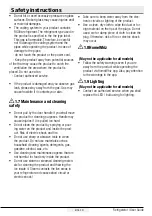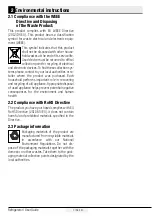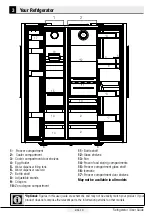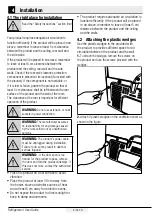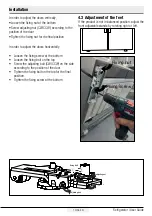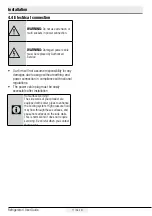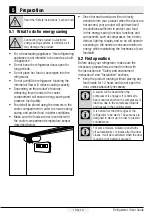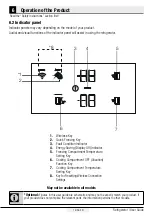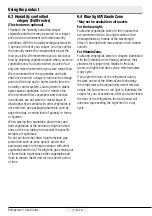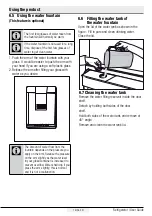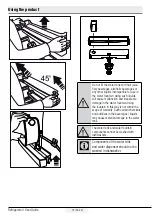
5 / 26 EN
Refrigerator / User Guide
Safety
i
nstruct
i
ons
tions made as per local or national regulations.
t
The product's power cable must be unplugged
during installation. Otherwise, risk of electric
shock and injury may occur!
t
Do not plug the product to loose, broken, dirty,
greasy sockets or sockets that has come out
their seats or sockets with a risk of water con-
tact.
t
Place the power cord and hoses (if available) of
the product so that they shall not cause a risk
of tripping over.
t
Penetration of humidity to live parts or to the
power cord may cause short circuit. Thus, do
not use the product in humid environments or
in areas where water may splash (e.g. garage,
laundry room, etc.) If the refrigerator is wet
by water, unplug it and contact an authorized
service.
t
Do not connect your refrigerator to power sav-
ing devices. These systems are harmful for the
product.
A
1.6
Operational safety
t
Do not use chemical solvents on the product.
These materials contain an explosion risk.
t
In case of a failure of the product, unplug it and
do not operate until it is repaired by the author-
ized service. There is a risk of electric shock!
t
Do not place a source of flame (e.g. candles,
cigarettes, etc.) on the product or in the vicinity
of it.
t
Do not get on the product. Risk of falling and
injury!
t
Do not cause damage to the pipes of the cool-
ing system using sharp and piercing tools. The
refrigerant that sprays out in case of puncturing
the gas pipes, pipe extensions or upper surface
coatings may cause irritation of skin and inju-
ries of the eyes.
t
Do not place and operate electric appliances
inside the refrigerators/deep freezer unless it is
advised by the manufacturer.
t
Do not jam any parts of your hands or your
body to the moving parts inside the product.
Be careful to prevent jamming of your fingers
between the refrigerator and its door. Be careful
while opening or closing the door if there are
children around.
t
Do not put ice cream, ice cubes or frozen food
to your mouth as soon as you take them out of
the freezer. Risk of frostbite!
t
Do not touch the inner walls, metal parts of the
freezer or food kept inside the refrigerator with
wet hands. Risk of frostbite!
t
Do not place soda cans or cans and bottles
that contain fluids that may be frozen to the
freezer compartment. Cans or bottles may ex-
plode. Risk of injury and material damage!
t
Do not use or place materials sensitive against
temperature such as flammable sprays, flam-
mable objects, dry ice or other chemical agents
in the vicinity of the refrigerator. Risk of fire and
explosion!
t
Do not store explosive materials such as aero-
sol cans with flammable materials inside the
product.
t
Do not place cans containing fluids over the
product. Splashing of water on an electrical
part may cause the risk of an electric shock or
a fire.
t
This product is not intended for storage and
cooling of medicines, blood plasma, laboratory
preparations or similar materials and prod-
ucts that are subject to the Medical Products
Directive.
t
If the product is used against its intended pur-
pose, it may cause damage to or deterioration
of the products kept inside.
t
If your refrigerator is equipped with blue light,
do not look at this light with optical devices.
Do not stare directly at UV LED light for a long
time. Ultraviolet rays may cause eye strain.
t
Do not fill the product with more food than its
capacity. Injuries or damages may occur if the
contents of the refrigerator falls when the door
is opened. Similar problems may occur when
an object is placed over the product.
t
Ensure that you have removed any ice or water
that may have fallen to the floor to prevent
injuries.
t
Change the locations of the racks/bottle racks
on the door of your refrigerator while the racks
are empty only. Danger of physical injury!
t
Do not place objects that may fall/tipped over
on the product. These objects may fall while
opening or closing the door and cause injuries
and/or material damages.


